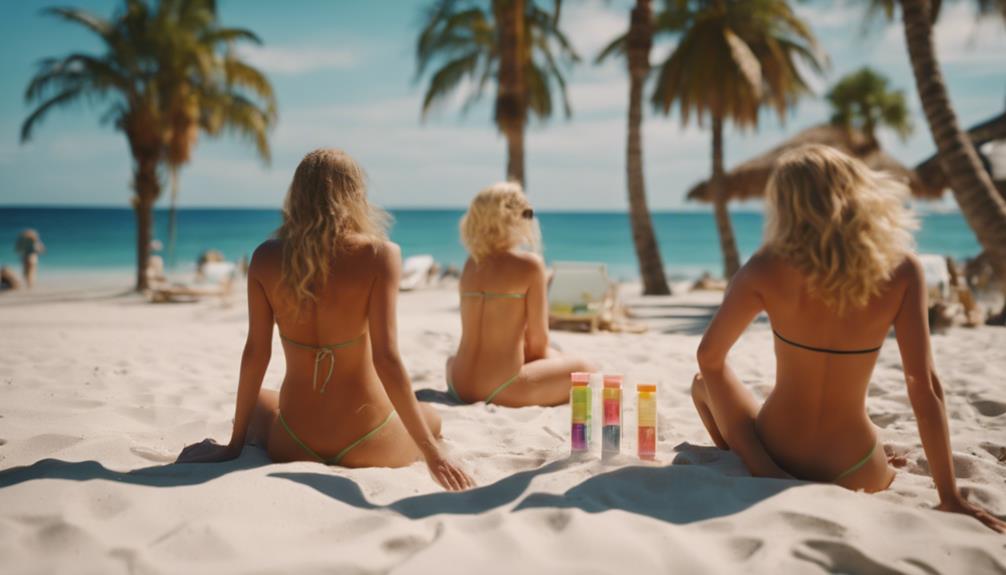Ready to glow without the sunburn? Search no further than sunless tanning! Products like self-tanning lotions and gradual moisturizers let you achieve that perfect bronze without harmful UV rays. Want something quicker? Try a spray tan—it gives you a fabulous shine in no time! Just remember to prep your skin by exfoliating and moisturizing first; it makes all the difference. And don't skip using tanning mitts; they keep your hands streak-free. With the right techniques, you can rock a healthy, sun-kissed look that'll turn heads. Stick around to discover more tips for the ultimate tanning experience!
Key Takeaways
- Self-tanning lotions provide a UV-free option for achieving a bronzed look without damaging the skin.
- Gradual tanning moisturizers hydrate the skin while allowing for a gradual build-up of color.
- Tinted sunscreens offer both sun protection and a subtle enhancement of skin tone.
- Regular exfoliation and moisturizing enhance tanning results and promote overall skin health.
Understanding Sunless Tanning Products
Sunless tanning products offer a safe and effective way to achieve a bronzed look without the risks associated with UV exposure.
You've got options like sunless tanning lotions, which use a magic ingredient called Dihydroxyacetone (DHA) to react with your skin's top layer, giving you that sun-kissed glow.
Don't forget to prep your skin by exfoliating and moisturizing for the best results!
If you prefer a more gradual approach, gradual tanning moisturizers let you build your color slowly, so you won't end up looking like a walking carrot.
Plus, tinted sunscreens give you a little color while protecting your skin from harmful rays.
With sunless tanning, you can shine bright without worrying about sun damage or skin cancer!
Exploring Spray Tan Options

When you're looking for a quick and effective way to achieve a sun-kissed glow, exploring spray tan options can be a game changer.
Imagine stepping into a spray tan booth, feeling like a celebrity getting ready for a red carpet event! There are various booths to choose from, each offering unique benefits.
You can get a tan that lasts between 7 to 10 days, giving you that radiant look without the harmful UV rays. Plus, with professional assistance, you'll avoid any embarrassing streaks!
Just make sure to pick a reputable place with good reviews, and you'll be golden—literally! So, if you want to glow like you just returned from a tropical vacation, spray tans are definitely worth considering.
Effective Application Techniques

Mastering effective application techniques can greatly enhance your sunless tanning results, ensuring a natural and even glow.
First, always start with clean, exfoliated skin to remove dead cells—think of it as giving your skin a fresh canvas!
Next, apply your chosen product evenly, using circular motions to blend it in.
Don't forget those tricky spots like your elbows and knees; they can soak up more color, so use less there.
A tanning mitt works wonders to avoid streaks and keep your hands looking normal, not like a carrot!
Finally, let your tan dry completely before getting dressed.
Just think, a little patience now means you'll strut around with a fabulous sun-kissed look later!
Enjoy your glow!
Benefits of Professional Tanning

Professional tanning offers numerous advantages, ensuring you achieve a flawless, natural-looking bronze tailored to your unique skin tone.
When you go to a professional, you get a customized experience that considers your specific needs, so no more guessing games! The skilled technicians know just how to mix shades to match your complexion perfectly, leaving you with a sun-kissed glow that looks like you just returned from a beach vacation—without the sunburn!
Plus, professional airbrush tanning minimizes streaks and uneven patches, so you can strut your stuff with confidence.
And let's not forget, you're avoiding harmful UV rays! So, why not treat yourself to a pampering session? You deserve to shine bright like the star you are!
Healthier Tanning Alternatives

Exploring healthier tanning alternatives means you can achieve that coveted glow without the risks associated with UV exposure. You've got plenty of options, from self-tanning lotions to tinted sunscreens! Each method is designed to give you that sun-kissed look without frying your skin. Check out the table below to see some popular choices:
| Tanning Method | Benefits | Application Time |
|---|---|---|
| Self-Tanning Lotion | UV-free, easy to apply | 2-4 hours to develop |
| Gradual Tanning Moisturizer | Hydrating, builds color slowly | Daily use |
| Tinted Sunscreen | Sun protection, enhances skin tone | Daily application |
Maintaining Overall Skin Health

Maintaining overall skin health requires a combination of proper hydration, balanced nutrition, and consistent skincare routines. Your skin deserves the best, so keep it glowing with these simple steps:
- Drink Water: Hydration is key. Aim for at least eight glasses a day to keep your skin plump and happy.
- Eat Nutrient-Rich Foods: Load your plate with fruits, veggies, and healthy fats to nourish your skin from the inside out.
- Moisturize Daily: A good moisturizer helps lock in hydration and prevent dryness, giving your skin that fresh, dewy look.
- Exfoliate Regularly: Gently sloughing off dead skin cells helps reveal the glowing skin beneath, making your self-tanner application smoother and more even.
With these tips, you'll keep your skin looking fabulous while enjoying that sun-kissed glow!
Tips for Successful Self-Tanning

How can you achieve a flawless tan at home?
First, prep your skin by exfoliating to remove dead cells and moisturizing to keep it hydrated. This step's essential because it helps your tan go on smoothly, avoiding those pesky streaks!
Next, choose a self-tanner that suits your skin tone and apply it evenly using a mitt to prevent orange hands—nobody wants that! Remember to start with a little product, building up color gradually for a more natural look.
Don't forget to wash your hands after application, too!
Finally, wait a few hours before showering to let the color develop fully.
With these tips, you'll be rocking that sun-kissed glow in no time, so get ready to shine!
Resources for Safe Tanning Practices

To guarantee a safe and effective tanning experience, it's important to utilize reliable resources that guide you in making informed choices.
Here's a quick list to help you out:
- Online Guides: Check out articles and blogs dedicated to safe tanning practices; they're packed with tips!
- Product Reviews: Before buying any self-tanner, read reviews to avoid those dreaded orange mishaps.
- YouTube Tutorials: Visual learners rejoice! Watch videos for application techniques that'll leave you looking fabulous.
- Consult Professionals: When in doubt, chatting with a tanning expert can provide personalized advice tailored just for you.
Frequently Asked Questions
How Long Does a Sunless Tan Typically Last?
A sunless tan typically lasts between five to ten days, depending on your skin type and maintenance. To prolong it, moisturize regularly and avoid excessive exfoliation, ensuring a beautiful, even glow throughout its duration.
Can Sunless Tanning Products Cause Skin Irritation?
Yes, sunless tanning products can cause skin irritation for some people, especially if they have sensitive skin or allergies. It's essential to patch test new products and choose formulations designed for sensitive skin to minimize adverse reactions.
Are Sunless Tanning Products Safe for Sensitive Skin?
Sunless tanning products can be safe for sensitive skin, but it's essential to patch-test first. Choose formulations labeled hypoallergenic or for sensitive skin, and always follow instructions for best results without irritation.
How Do I Remove a Sunless Tan if Needed?
Wondering how to remove that sunless tan? You can gently exfoliate your skin with scrub or a loofah, use a tan remover product, or soak in a warm bath to fade the color effectively.
Can I Use Makeup Over My Sunless Tan?
Yes, you can use makeup over your sunless tan. Just guarantee your tan has fully developed, and apply a light moisturizer beforehand to create a smooth base, helping your makeup blend seamlessly without disrupting your tan.
What Are the Healthier Alternatives for Sunless Tanning?
Looking for healthier alternatives for sunless tanning? Consider using organic self-tanning lotions or sprays, as they provide a flawless sunless tanning achieved without exposing your skin to harmful UV rays. Additionally, bronzers and tinted moisturizers can offer a natural-looking glow without the risk of sun damage.
Conclusion
So, there you have it! With sunless tanning, you can shine like a star without the sun's harmful rays.
Whether you choose lotions, sprays, or even professional services, you can achieve that gorgeous glow safely.
Remember, just like a good pizza needs the right toppings, your tanning routine needs the right products and techniques.
So go ahead, embrace your bronzed beauty, and let your skin stay happy and healthy while you glow!








